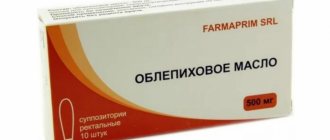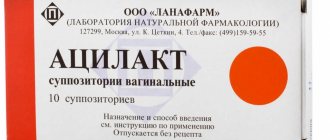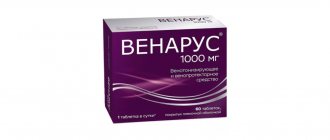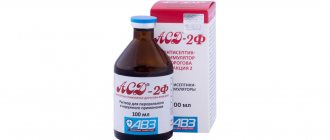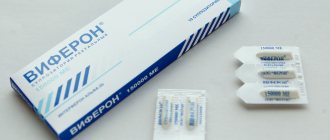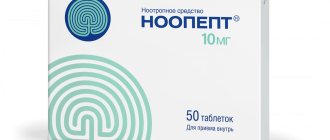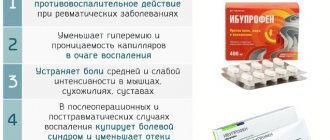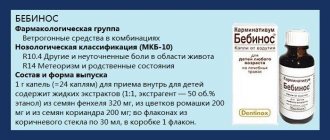Indications for use and contraindications
The instructions advise prescribing suppositories to patients:
- with urogenital chlamydial infection, including complications in the form of vaginal dysbiosis, inflammation or erosive lesions of the uterine cervix, vulvovaginitis;
- herpes, viral hepatitis - in childhood;
- gastrointestinal infections;
- inflammatory processes in the respiratory system, pneumonia, chronic bronchitis;
- d=disturbance of the microflora of the vagina and intestines of various etiologies.
The drug can be used in preliminary preparation for a variety of operations, including gynecological ones. Taking it helps prevent secondary infections.
Kipferon is contraindicated in patients with individual intolerance to the component composition. The annotation does not contain information about plug reactions that have occurred to therapeutic procedures with suppositories.
Kipferon
Kipferon supp vag and rect 200 mg+500000 IU x5, ATX code: G02CC (Anti-inflammatory drugs for intravaginal use)
Active substances
human normal immunoglobulin Ph.Eur. European Pharmacopoeia interferon alfa (interferon alfa) Rec.INN registered by WHO
Dosage form
Suppositories for vaginal and rectal administrationreg. No.: Р N000126/01 dated 02/28/11 - Indefinitely
Release form, packaging and composition of the drug Kipferon
Suppositories for vaginal or rectal administration 1 sup.
plasma protein (including IgM, IgA, IgG) 60 mg
interferon alpha 500 thousand IU, Clinical and pharmacological group: Immunomodulator. Combination of immunoglobulin with interferon Pharmacotherapeutic group: MIBP-cytokine
pharmachologic effect
The drug has immunostimulating, antiviral, antiherpetic effects.
As part of complex therapy, it is used to treat chlamydia.
Indications for the drug Kipferon
The drug is used in the treatment of acute respiratory diseases, inflammatory diseases of the oropharynx of bacterial and viral etiology, acute viral (rotavirus) and bacterial (salmonellosis, dysentery, coli infection) intestinal infections, intestinal dysbiosis of various origins in children, in the treatment of urogenital chlamydia in women, including manifestations of vaginal dysbacteriosis, vulvovaginitis, cervinitis of the cervix, and cervical erosion. The drug is also used against the background of generally accepted specific therapy.
ICD-10 codes
Dosage regimen
Suppositories containing immunoglobulin complex preparation (ICP) 0.2 g and human interferon alpha-2b, recombinant 500,000 IU as active substances, are used vaginally or rectally.
For acute respiratory diseases, inflammatory diseases of the oropharynx of bacterial and viral etiology, for viral (rotavirus) and bacterial (salmonella, dysentery, colo-infection) intestinal infections in children, intestinal bacteriosis of various origins, suppositories are prescribed depending on the age of the patients:
in the first year, 1 suppository per day rectally. (in 1 dose), from 1 to 3 years - 1 suppository twice a day, after 3 years - 1 suppository three times a day for 5-7 days.
In patients with tonsillitis with a pronounced purulent process, the course of treatment should be extended to 7-8 days.
Suppositories are used without specific therapy or simultaneously with it.
When treating urogenital chlamydia in women, suppositories are administered deeply intraginally (before contact with the posterior vaginal vault and cervix) 1-2 suppositories, depending on the severity of the disease, twice a day. The course of treatment is on average 10 days; in the presence of cervical erosion, the use of the drug is continued until its epithelization. According to indications, the course of treatment can be repeated. Treatment should begin in the first days after the end of menstruation. Before insertion, it is recommended to remove mucus from the mucous membranes of the vagina and cervix.
Contraindications for use
Individual intolerance to individual components, pregnancy and lactation.
Use during pregnancy and lactation Contraindicated during pregnancy and lactation.
Use in children Use is possible according to the dosage regimen.
Storage conditions for the drug Kipferon
Store the drug at a temperature of 2°C to 8°C, out of the reach of children.
Shelf life of the drug Kipferon Shelf life - 1 year 6 months. Do not use after the expiration date indicated on the package.
Terms of sale The drug is approved for use as an over-the-counter product.
Admission rules
The instructions provide for rectal and vaginal administration of the medicine. In childhood, preference is given to the first option. Therapy is carried out twice a day, 1-2 suppositories. Erosive lesions are treated until the damaged surfaces heal. The process begins immediately after the completion of the monthly cycle; before insertion, accumulated secretions are removed from the surface of the vagina and uterus.
The main therapeutic regimen depends on the type of current pathological process:
Chlamydia
For children - one suppository per day, treatment lasts 10 days. For girls with asymptomatic inflammatory processes, therapy is carried out in combination with eubiotics. In difficult cases, antibacterial drugs are added to them.
For adults – 1-2 suppositories twice a day, treatment lasts up to 2 weeks in a row. A course of antibiotics and eubiotics is added to Kipferon. A repeat course is recommended for patients with persistent symptoms of the underlying pathology.
Viral hepatitis
Suppositories are administered rectally:
- children under 7 years old - 5 thousand IU per kilogram of weight, the total amount is divided into two manipulations, the dosage does not exceed 1 million IU per day;
- from 8 to 11 years – 3 units per day;
- over 12 years - four candles daily.
The duration of the procedures is 2 weeks, the first 7 days the medicine is administered every day, later - with an interval of 72 hours. Chronic viral hepatitis is treated for one calendar month.
Respiratory damage
Kipferon is prescribed rectally, as a suppository twice a day. Daily therapy lasts 5 days, then the next three weeks - with an interval of 72 hours. The drug is used both in a complex course together with antibacterial agents, and in independent treatment.
Genital herpes
For adults - from 2 to 4 suppositories for 14 days, for children - one light for 10 days. The addition of antibacterial therapy is justified only when a secondary infection occurs. The female sex should begin manipulations after the end of menstruation; before they are carried out, cleansing douching is performed.
Gastrointestinal infections in children
Suppositories are administered rectally after a cleansing enema or natural bowel emptying. Features of the course depend on the patient’s age:
- up to 12 years – 5 thousand IU per kilogram of body weight, no more than 2 units per day;
- over 12 years old – up to four candles per day.
The effectiveness of the drug is directly related to the timing of the start of therapy: if used in the first three days from the onset of the first symptoms, the results will be better. The duration of manipulations for viral diarrhea does not exceed 5 days, in case of severe cases - one calendar week.
Preoperative preparation
Therapy includes rectal administration of Kipferon, one suppository, morning and evening, with a mandatory break of 12 hours. Prevention is prescribed 72 hours before the date of surgery, the medication can also be used during the rehabilitation period for 14 days.
Kipferon, 10 pcs., vaginal and rectal suppositories
Rectally, intravaginally (before contact with the posterior vaginal vault and cervix). 1-2 supp. (depending on the severity of the disease), 2 times a day. The course of treatment is on average 10 days; in the presence of cervical erosion, use is continued until its epithelization. According to indications, the course of treatment can be repeated. Treatment should begin in the first days after the end of menstruation. Before insertion, it is recommended to remove mucus from the mucous membranes of the vagina and cervix.
Prescription regimens for the drug Kipferon®, suppositories
Chlamydial infections
Children - 1 supp. 1 time per day, for 10 days. In girls with erased clinical forms of chlamydial vulvovaginitis and without clinical manifestations of the inflammatory process of the uterus and its appendages, chlamydial urinary tract infection, respiratory chlamydia, treatment is carried out only against the background of vaginal and oral administration of eubiotics; in other cases, treatment of chlamydia in children with Kipferon® is combined with the prescription of antibiotics and eubiotics.
Adults - a daily dose of 1-2 million IU (2-4 supp.) in 2 doses, course of treatment - 10-14 days; Additionally, antibiotic therapy is carried out and eubiotics are prescribed vaginally and orally. If clinical signs of chlamydia or chlamydia infection persist after treatment, a repeat course of therapy with Kipferon® is administered.
For viral hepatitis B, C and A in children
Rectally. For children under 7 years of age, Kipferon® is prescribed in a single dose of 50,000 IU/kg body weight in 2 doses, but not more than 1 million IU/day (2 sup.); 8–11 years – 1.5 million IU/day (3 sup.); over 12 years old - 2 million IU/day (4 supp.). The duration of treatment for acute viral hepatitis is 14 days. For the first 7 days, the drug is used daily, then 2 times a week. With a protracted course of the disease, the course duration reaches 3–4 weeks.
For frequent inflammatory diseases of the respiratory tract, recurrent bronchitis (including obstructive syndrome), pneumonia in children
Rectally. In a daily dose of 1 million IU (2 supp.) in 2 divided doses daily for the first 5 days, then 2 times a week for 3 weeks. It can be used as monotherapy or in complex treatment against the background of basic antibacterial therapy.
For genital herpes
Adults: 1–2 million IU (2–4 supp.) for 10–14 days; a repeat course of treatment is possible; for children - a daily dose of 500,000 IU (1 supp.) in 1 dose, course of treatment - 10 days.
Antibiotic therapy for genital herpes is carried out only in the presence of a concomitant bacterial infection. In women and teenage girls, treatment with the drug is recommended to begin in the first days after the end of menstruation. Before vaginal insertion, it is advisable to remove mucus with a tampon from the mucous membranes of the vagina and cervix.
For intestinal infections in children
Rectally (after a cleansing enema or defecation). Children under 12 years old - in an average single dose of 50,000 IU/kg body weight, but not more than 1 million IU/day (2 supp.), over 12 years old - no more than 2 million IU (4 supp.). It is most advisable to use the drug in the first 3 days of the disease, i.e. during the acute period. The course of treatment for moderate viral diarrhea is 3–5 days; severe form - 7 days.
Kipferon® may be the only etiopathogenetic treatment (without antibacterial drugs) against the background of generally accepted basic therapy (oral rehydration, dosed therapeutic nutrition, and, if necessary, infusion therapy). In severe forms, it is advisable to include antibiotics in the complex of therapy.
In preparation for planned gynecological and other operations to prevent infectious complications
Rectally. Kipferon® is used in a daily dose of 1 million IU (2 sup.), in 2 doses, 3–5 days before and during surgery, as well as in the postoperative period. The course of treatment is 10–15 days. The interval between doses is 12 hours.
Manufacturer's advice
The annotation does not mention reported cases of overdose with suppositories. The instructions recommend paying attention to the following nuances of interaction with Kipferon of individual medications:
- the risk of renal damage increases with Amphotericin;
- liver diseases develop with Dicarbazine;
- an increase in toxic effect is observed with Doxorubicin.
When undergoing concurrent drug therapy, you need to warn your local doctor about them.
Analogs
Popular substitutes for Kipferon are presented:
- Vitaferon;
- Viferon;
- Genferon;
- Gepon;
- Glutoxim;
- Histamine dihydrochloride;
- Immunal;
- Imudon;
- Imunorix;
- Imunofan;
- Lavomax;
- Sodium nucleinate;
- Pyrogenal;
- Respibron;
- Ruzam;
- Ruferon;
- Septilin;
- Timalin;
- Uro-Vaxom;
- Phlogenzyme;
- Cycloferon;
- Cytovir-3;
- Engistoloim;
- Estifan.
The selection of a suitable analogue is carried out by the attending physician.
